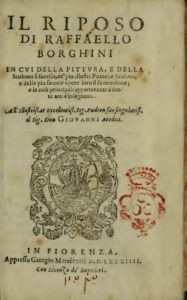
Not much is known about Raffaelo Borghini. He was probably born in Florence in 1537, and he may be identified with Raffaelo di Francesco di Raffaelo, the son of Francesco Borghini. In Il Riposo, his friendship with a certain Giambologna is mentioned. Raffaelo Borghini probably travelled to France in 1579, and he seems to have had a spiritual crisis that led him to abandon his literary work and made his friend Baccio Valori intervene. He not only wrote about artists, he also wrote plays.Il Riposo was published in Florence in 1584 and is dedicated to Giovanni Medici. It is about art and the lives of artists from Florence. The most famous writer in this regard is of course Vasari, but we don’t know if Borghini and Vasari knew each other. Borghini does briefly mention the Vite just as he mentions Pliny as a source for ancient art. Il Riposois much shorter than the Vite though. In Il Riposo, Borghini writes about Giotto working in the Camposanto, and Spinello Aretino is also given mention. Both descriptions are rather short but are nonetheless interesting. They only briefly mention the works these artists allegedly did in the Camposanto and focus more on the biographies of the artists. /SB
Borghini, Riposo 291-295, 302-303Source: Raffaello Borghini, Il Riposo in cui della Pittura, e della Scultura si favella, de’ più illustri Pittori, e Sculturi, e delle più famose opere loro si fa mentione, e le cose principali appartenenti à delle arti s’insegnano (Florence: G. Marescotti, 1584).
Libro Terzo
“Da Cimabue apparò l’arte Giotto, il quale nacque l’anno 1276 nel contado di Firenze vicino alla Città quattordici miglia, in una villa detta Vespignano, di padre contadino […].
Ritornato [sc. Giotto] à Firenze [sc. da Assisi] dipinse una tavola entrovi San Francesco con molti bei paesi e historie della sua vita, la quale è oggi in San Francesco di Pisa, mediante la qual opera essendo chiamato da’ Pisani dipinse à fresco in Campo Santo l’historia di Giobbe in sei parti. Laonde spargendosi per tutto la fama dell’eccellenza d’un tanto huomo; mandò Papa Benedetto nono da Treviso un suo famigliare in Toscana per haver relatione delle cose di Giotto con animo da fargli in San Piero alcune pitture.” (291, 294-295)
Third Book
From Cimabue came the art of Giotto, who was born in 1276 in the region of Florence, 14 miles away from the city of Florence, in a villa named Vespignano, his father a farmer […].
As he [Giotto] returned from Assisi to Florence, he painted St. Francis with many beautiful towns and stories of his life, which is now in San Francesco in Pisa, through which, called by the Pisans, he painted in the Camposanto the story of Job in six parts. Therefore, this man’s reputation spread widely; Pope Benedict IX from Treviso sent a family member to Tuscany in order to get in contact with Giotto and he fervently persuaded him to paint a few pictures in St. Peter.
“Spinello di Luca Aretino nato in Arezzo fu poscia buon pittore. […] In San Miniato in Monte fuor di Firenze dipinse la sagrestia con molte historie della Vita di San Benedetto, e la tavola d’altare à tempera con bellissimi colori. Andatosene poi à Pisa dipinse in Campo Santo sei historie di San Petito, e di San Epiro, la qual opera fu la più bella, e la meglio condotta che facesse Spinello, la quale si è insino à hoggi molto fresca mantenuta. Dipinse ancora in San Francesco una Cappella entrovi l’historia di San Bartolomeo, e d’altri Apostoli.” (302, 303).
Spinello di Luca Aretino who was born in Arezzo was a good painter. […] In San Miniato outside of Florence he painted the sacristy with many stories from the life of St. Benedict and the altarpiece in tempera with beautiful colors. When he left for Pisa, he painted six stories of St. Petito and St. Epiro in the Camposanto. This work is the most beautiful and the best under the direction of Spinello and is well preserved until today. Then he further painted the story of St. Bartholomew and of other apostles in a chapel in San Francesco.
